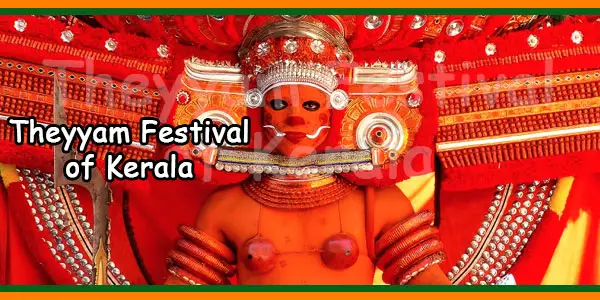Theyyam, a popular ritual art of north Kerala, is rich in culture. It is essentially a dance festival. The word “Theyyam” is modified from word ‘Deivam’ meaning God and ‘Aattam’ means dance. Hence, the meaning of Theyyam is ‘God’s dance’. During Theyyam, people of Kerala worship deity and dancer who is also the deity on that day. In this art, devotees usually worship Mother Goddess. Yet, some people worship animals, serpents and trees.
The season of Theyyam continues for six months. It begins from the Malayalam month of Thullam [October-November] and continues till Edavam [May-June]. Theyyam festivals are held in regions of Valapattanam River of Kannur, and Chandragiri River of Kasargod. This festival is prominent in the Theyyam of Malabar region in north Kerala.
About Theyyam Dance:
In particular castes of the people of Kerala, Theyyam is performed by male members only. There are some of the castes that perform the Theyyam in the society. They include Malayan, Pulayan, Vannan, Anjoottan, Munnutton, Velan, Chungathan, Koppalan and Mayilon.

Theyyam dance has its roots in the ancient tribal culture dating back to the Dravidian age. This Theyyam dance festival gives great importance to the worship of heroes and ancestral spirits. During Theyyam dance a wonderful amalgamation of dance, mime and music is performed. The various musical instruments used in Theyyatom include Chenda, Veekku Chenda, Elathalam and Kurumkuzhal.
There are about 450 known forms of “theyyams”. Each has its own myth and style of costumes, make-up, choreography and songs. Even to this day, there are some theyyams performed. They include Rakthachamundi, Makkappothi, Puliyoru Kannan, Pottan, Kathivanur Veeran, Muchhilottu Bhagavathi, Palothu Daivam, and Vishnumurthy. Others are Puthiya Bhagavathi, Vayanattu Kulavan, Ucchitta, Gulikan, Nagakanni, Mutiappan, Veerali, Puliyoru kali, Panchuruli, and Kuttissasthav.
There is an influence of prominent Hindu sects are apparent on Theyyam cult. Sects include Shakteyas [Mother Goddess Shakti’s followers], Vaishnavites [Lord Vishnu’s followers] and Shaivites [Lord Shiva’s followers]. Theyyam is supported by a vast literature of folk songs. The theme of worshiping Mother Goddesses and animals is common. Also, Theyyam narrates the tales and woes of people who lost their lives in battlefield. Others include pangs of women who committed suicide or persons killed by the local chieftains. Thus, people are remembered and honoured through theyyams performed in front of shrines.
Theyyam festival is also known as “Kaliyattom” at some places. Kaliyattom means “the sacred dance performance for goddess Kali”. Some believe that Kaliyattom is called Theyyattom because every ‘thera’ [village] has to perform it. There are two stages in Theyyattom – Thottam, the preliminary ritual, and Theyyam. Some Theyyams have an additional stage called Vellattom. The myth of the deity is recited by Thottam through songs accompanied by an orchestra. Theyyam is the second stage.
Costume and Make-up
Dancers represent persons so they wear special colourful costumes and use make-up in Theyyam dances. There are essential component of the costumes of Theyyam dance. The leaves of the coconut tree are cut and made into different shapes and sizes.
Head-gear of the Theyyam dancers is unique and special. Structure of massive headgear and uduthukettu [waist-dress] is usually prepared from Arecanut tree and bamboo. Lighted wicks are often fixed on the waist dress and are specific of Theyyattom. Mudi [face] is decorated with a red cloth and coloured papers. Red coloured flowers are also used for an even more attractive appearance.
